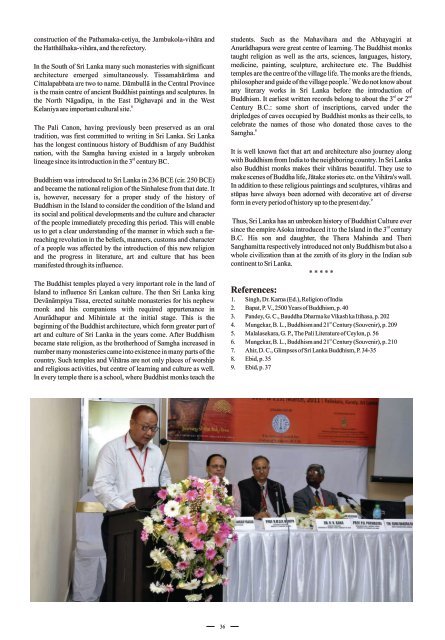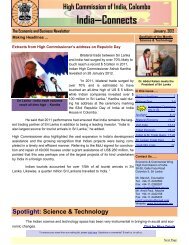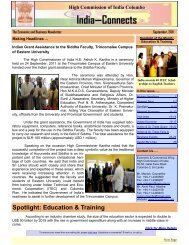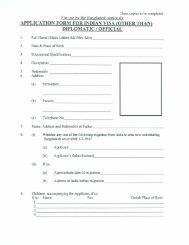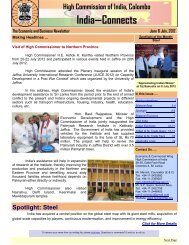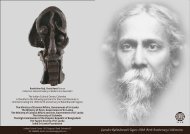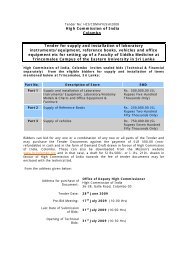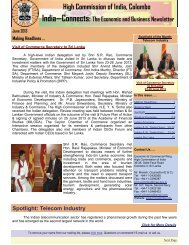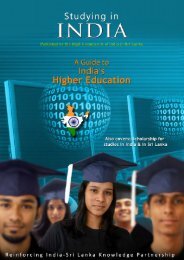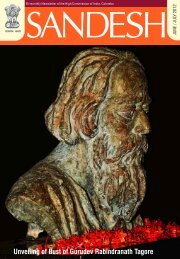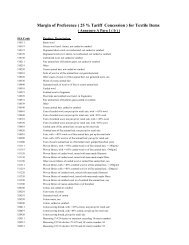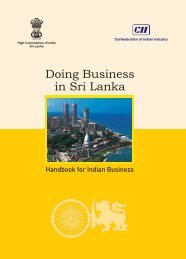Papers presented at the International Buddhist Conference, March ...
Papers presented at the International Buddhist Conference, March ...
Papers presented at the International Buddhist Conference, March ...
Create successful ePaper yourself
Turn your PDF publications into a flip-book with our unique Google optimized e-Paper software.
construction of <strong>the</strong> P<strong>at</strong>hamaka-cetiya, <strong>the</strong> Jambukola-vihāra and<br />
<strong>the</strong> H<strong>at</strong>thālhaka-vihāra, and <strong>the</strong> refectory.<br />
In <strong>the</strong> South of Sri Lanka many such monasteries with significant<br />
architecture emerged simultaneously. Tissamahārāma and<br />
Cittalapabb<strong>at</strong>a are two to name. Dāmbullā in <strong>the</strong> Central Province<br />
is <strong>the</strong> main centre of ancient <strong>Buddhist</strong> paintings and sculptures. In<br />
<strong>the</strong> North Nāgadipa, in <strong>the</strong> East Dighavapi and in <strong>the</strong> West<br />
6<br />
Kelaniya are important cultural site.<br />
The Pali Canon, having previously been preserved as an oral<br />
tradition, was first committed to writing in Sri Lanka. Sri Lanka<br />
has <strong>the</strong> longest continuous history of Buddhism of any <strong>Buddhist</strong><br />
n<strong>at</strong>ion, with <strong>the</strong> Samgha having existed in a largely unbroken<br />
rd<br />
lineage since its introduction in <strong>the</strong> 3 century BC.<br />
Buddhism was introduced to Sri Lanka in 236 BCE (cir. 250 BCE)<br />
and became <strong>the</strong> n<strong>at</strong>ional religion of <strong>the</strong> Sinhalese from th<strong>at</strong> d<strong>at</strong>e. It<br />
is, however, necessary for a proper study of <strong>the</strong> history of<br />
Buddhism in <strong>the</strong> Island to consider <strong>the</strong> condition of <strong>the</strong> Island and<br />
its social and political developments and <strong>the</strong> culture and character<br />
of <strong>the</strong> people immedi<strong>at</strong>ely preceding this period. This will enable<br />
us to get a clear understanding of <strong>the</strong> manner in which such a farreaching<br />
revolution in <strong>the</strong> beliefs, manners, customs and character<br />
of a people was affected by <strong>the</strong> introduction of this new religion<br />
and <strong>the</strong> progress in liter<strong>at</strong>ure, art and culture th<strong>at</strong> has been<br />
manifested through its influence.<br />
The <strong>Buddhist</strong> temples played a very important role in <strong>the</strong> land of<br />
Island to influence Sri Lankan culture. The <strong>the</strong>n Sri Lanka king<br />
Devānāmpiya Tissa, erected suitable monasteries for his nephew<br />
monk and his companions with required appurtenance in<br />
Anurādhapur and Mihintale <strong>at</strong> <strong>the</strong> initial stage. This is <strong>the</strong><br />
beginning of <strong>the</strong> <strong>Buddhist</strong> architecture, which form gre<strong>at</strong>er part of<br />
art and culture of Sri Lanka in <strong>the</strong> years come. After Buddhism<br />
became st<strong>at</strong>e religion, as <strong>the</strong> bro<strong>the</strong>rhood of Samgha increased in<br />
number many monasteries came into existence in many parts of <strong>the</strong><br />
country. Such temples and Vihāras are not only places of worship<br />
and religious activities, but centre of learning and culture as well.<br />
In every temple <strong>the</strong>re is a school, where <strong>Buddhist</strong> monks teach <strong>the</strong><br />
students. Such as <strong>the</strong> Mahavihara and <strong>the</strong> Abhayagiri <strong>at</strong><br />
Anurādhapura were gre<strong>at</strong> centre of learning. The <strong>Buddhist</strong> monks<br />
taught religion as well as <strong>the</strong> arts, sciences, languages, history,<br />
medicine, painting, sculpture, architecture etc. The <strong>Buddhist</strong><br />
temples are <strong>the</strong> centre of <strong>the</strong> village life. The monks are <strong>the</strong> friends,<br />
7<br />
philosopher and guide of <strong>the</strong> village people. We do not know about<br />
any literary works in Sri Lanka before <strong>the</strong> introduction of<br />
rd nd<br />
Buddhism. It earliest written records belong to about <strong>the</strong> 3 or 2<br />
Century B.C.: some short of inscriptions, carved under <strong>the</strong><br />
dripledges of caves occupied by <strong>Buddhist</strong> monks as <strong>the</strong>ir cells, to<br />
celebr<strong>at</strong>e <strong>the</strong> names of those who don<strong>at</strong>ed those caves to <strong>the</strong><br />
8<br />
Samgha.<br />
It is well known fact th<strong>at</strong> art and architecture also journey along<br />
with Buddhism from India to <strong>the</strong> neighboring country. In Sri Lanka<br />
also <strong>Buddhist</strong> monks makes <strong>the</strong>ir vihāras beautiful. They use to<br />
make scenes of Buddha life, Jātake stories etc. on <strong>the</strong> Vihāra's wall.<br />
In addition to <strong>the</strong>se religious paintings and sculptures, vihāras and<br />
stūpas have always been adorned with decor<strong>at</strong>ive art of diverse<br />
9<br />
form in every period of history up to <strong>the</strong> present day.<br />
Thus, Sri Lanka has an unbroken history of <strong>Buddhist</strong> Culture ever<br />
rd<br />
since <strong>the</strong> empire Aśoka introduced it to <strong>the</strong> Island in <strong>the</strong> 3 century<br />
B.C. His son and daughter, <strong>the</strong> Thera Mahinda and Theri<br />
Sanghamitta respectively introduced not only Buddhism but also a<br />
whole civiliz<strong>at</strong>ion than <strong>at</strong> <strong>the</strong> zenith of its glory in <strong>the</strong> Indian sub<br />
continent to Sri Lanka.<br />
* * * * *<br />
References:<br />
1. Singh, Dr. Karna (Ed.), Religion of India<br />
2. Bap<strong>at</strong>, P. V., 2500 Years of Buddhism, p. 40<br />
3. Pandey, G. C., Bauddha Dharma ke Vikash ka Itihasa, p. 202<br />
st<br />
4. Mungekar, B. L., Buddhism and 21 Century (Souvenir), p. 209<br />
5. Malalasekara, G. P., The Pali Liter<strong>at</strong>ure of Ceylon, p. 56<br />
st<br />
6. Mungekar, B. L., Buddhism and 21 Century (Souvenir), p. 210<br />
7. Ahir, D. C., Glimpses of Sri Lanka Buddhism, P. 34-35<br />
8. Ebid, p. 35<br />
9. Ebid, p. 37<br />
36


